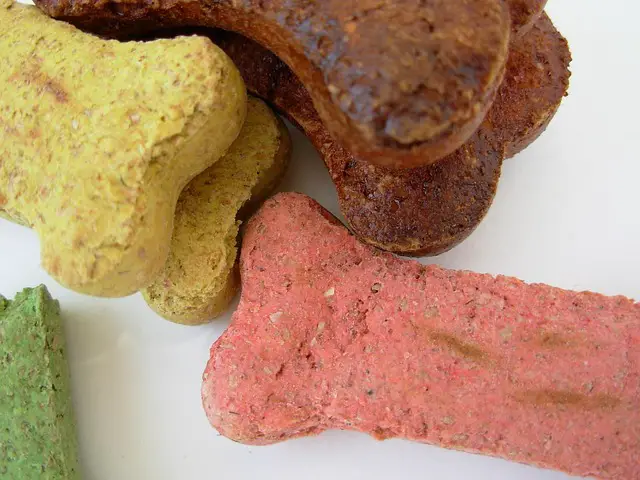Hey there, fellow pet owners! We all want the best for our furry friends, right? And part of that is making sure they have a healthy and balanced diet. Now, we all love treating our dogs, and Dentastix is quite a popular choice when it comes to dental treats.
But have you ever wondered what happens if your dog goes a little overboard and devours too many Dentastix?
Well, stick around, because in this article, we’re going to dive into the potential consequences of excessive Dentastix consumption and share some insights on how to maintain a healthy treat routine for your beloved canine companion.
Dentastix Overview
So, what exactly is Dentastix? These are dental chews that are specially designed to promote oral health in our furry buddies. They come in different flavors and sizes, and they have this unique texture that encourages dogs to chew.
By chewing on Dentastix, our furry friends can help keep their teeth and gums clean, reducing the buildup of plaque and tartar. And you know what that means? Better breath and improved dental hygiene!
The Importance of Oral Health for Dogs
Just like us humans, dogs can also experience dental issues. Think gum disease, tooth decay, and bad breath. Yeah, nobody wants their doggo to have stinky breath, right? That’s why maintaining good oral hygiene is crucial for their overall health. And this is where dental treats like Dentastix come into play.
By incorporating regular dental care, such as brushing their teeth and giving them dental treats, we can help our dogs have healthier gums and teeth, preventing potential dental problems in the long run.
Serving Size Matters
Now, pay attention, folks. To ensure your dog’s well-being, it’s important to follow the recommended serving size provided by the manufacturer. You see, Dentastix packaging usually includes guidelines on the appropriate amount of treats based on your dog’s size and weight.
And hey, these guidelines are there for a reason! By following them, you can prevent overconsumption and any potential adverse effects that might come along with it.
The Risks of Going Overboard
Alright, let’s talk about the risks of excessive Dentastix consumption. While these dental treats are great when used correctly, feeding your dog too many can lead to some unwanted consequences. So, here’s what you need to be aware of:
Digestive Issues
If your dog goes on a Dentastix binge, it can mess with its digestive system. You see, these treats have a high fiber content, and when eaten in excess, they can cause gastrointestinal problems like diarrhea, stomach upset, or even constipation.
Not something we want for our four-legged pals, right? If you notice any digestive disturbances, it’s essential to consult your veterinarian for some expert guidance.
Weight Gain
Now, we all love our dogs no matter their shape or size, but excessive Dentastix consumption can contribute to weight gain. These treats contain calories, just like any other treat out there. And if your dog munches on too many Dentastix, they might start putting on some extra pounds.
That can lead to obesity and a whole bunch of related health issues. So, keep an eye on their calorie intake and adjust their regular meals accordingly to help them maintain a healthy weight.
Dental Problems
This one might surprise you. While Dentastix can improve oral health when consumed in moderation, eating too many of them can actually lead to dental problems. It’s a bit of a paradox, right? You see, Dentastix has a chewy texture that’s designed to scrape away plaque and tartar from your dog’s teeth.
But if they go overboard and devour an excessive amount of Dentastix, it can result in sticky residue building up on their teeth.
And guess what? That sticky residue can actually increase the risk of plaque and tartar buildup, leading to dental issues like tooth decay, gum inflammation, and even tooth loss. Yikes! So, remember, moderation is key when it comes to these dental treats.
Ingredient Sensitivities
Now, this one is a little less common, but it’s still worth mentioning. Some dogs may have sensitivities or allergies to certain ingredients present in Dentastix. While it’s rare, it’s important to keep an eye out for any signs of adverse reactions.
If you notice your furry friend itching, developing skin rashes, or experiencing gastrointestinal distress after eating Dentastix, it’s best to discontinue use and consult with your veterinarian.
They can help you determine if your dog is having an allergic reaction and provide appropriate guidance.
Maintaining a Balanced Treat Routine
Alright, we’ve covered the potential risks, but don’t worry, it’s not all doom and gloom! There are ways to maintain a balanced treatment routine for your dog and keep their oral health in check. Here are some tips to keep in mind:
Follow the Recommended Serving Size
I know I’ve mentioned this before, but it’s so important that it deserves another shout-out. Always stick to the recommended serving size provided on the Dentastix packaging.
They’ve done the math and taken into account your dog’s size and weight, so trust their expertise and give your pup the appropriate portion.
Treats Are Supplements, Not Replacements
Remember, treats should never replace your dog’s regular meals. Dentastix should be seen as a supplement to their balanced and nutritious diet, not the main course.
So, make sure your furry friend is getting all the nutrients they need from their regular food, and use Dentastix as an added bonus for their dental health.
Variety Is the Spice of Life
Hey, who says Dentastix has to be the only dental treat in town? Incorporate other dental chews and toys into your dog’s routine. Mixing things up not only keeps them engaged and entertained but also promotes overall oral health.
So, go ahead and explore the different options out there. Your dog will thank you for the variety!
Keep an Eye on the Scale
Monitoring your dog’s weight is essential for their overall well-being. If you notice any weight gain or obesity, it’s time to reassess your treatment portion. Adjust the number of Dentastix or other treats they receive to help them maintain a healthy weight.
And of course, if you’re not sure about the right portion size or any other concerns, don’t hesitate to reach out to your veterinarian. They’re the experts, after all!
Alternatives to Dentastix
Now, if you’re feeling a bit wary about Dentastix or if your dog has specific dietary needs, fret not! There are alternatives out there. Talk to your veterinarian and explore other dental treatment options that suit your dog’s preferences and requirements.
There’s a wide variety of dental chews, bones, and toys designed to promote oral health.
And hey, regular teeth brushing with dog-friendly toothpaste and dental check-ups are fundamental aspects of maintaining optimal oral hygiene. So, don’t be afraid to mix and match to find the best routine for your furry friend!
Consult with a Veterinarian
When in doubt, don’t hesitate to reach out to your trusted veterinarian. They are the real pros when it comes to your dog’s health, including their dental well-being. If you have any concerns about your dog’s dental health or the appropriate use of Dentastix, consulting with your veterinarian is always a great idea.
They can provide personalized advice based on your dog’s specific needs and help you establish an effective dental care routine tailored just for them.
Conclusion
Alright, folks, here’s the bottom line. Dentastix can be a fantastic tool in promoting your dog’s oral health, as long as they are used in moderation.
Remember to follow the recommended serving size, view them as a supplement rather than a replacement for a balanced diet, and keep an eye on your dog’s overall health and weight.
By maintaining a balanced treatment routine and seeking guidance from your veterinarian, you can ensure that your furry friend’s dental well-being is in good hands.
FAQs
Can I give Dentastix to puppies?
Absolutely! Dentastix can be given to puppies. However, it’s important to choose the appropriate size specifically designed for puppies.
Follow the recommended serving size and consult with your veterinarian for guidance on introducing dental treats into your puppy’s diet. They’ll steer you in the right direction.
How often should I give my dog Dentastix?
The frequency of giving your dog Dentastix depends on various factors, such as their age, dental health, and overall diet. As a general rule of thumb, it’s recommended to offer dental treats like Dentastix a few times a week as part of a balanced treatment routine. Remember, moderation is key!
Are Dentastix suitable for all dog breeds?
Yes, Dentastix is generally suitable for dogs of all breeds. However, it’s important to consider any specific dietary needs or sensitivities that your dog may have. If your furry friend has any known allergies or sensitivities to certain ingredients,
it’s best to have a chat with your veterinarian before introducing Dentastix or any other treats into their diet. Safety first!
Can my dog eat Dentastix every day?
While Dentastix can be part of your dog’s regular dental care routine, it’s generally recommended to provide them a few times a week rather than every single day.
Remember, variety is important too! This helps maintain a balanced treatment regimen and prevents overconsumption. Plus, it keeps things interesting for your dog’s taste buds.
Are there any alternatives to Dentastix for maintaining my dog’s oral health?
Absolutely! If you’re looking for alternatives to Dentastix, there are plenty of options out there. Dental chews, bones, and toys specifically designed to promote oral health can be great alternatives.
Don’t forget the importance of regular teeth brushing using dog-friendly toothpaste as well. Talk to your veterinarian to explore the options and find the best fit for your dog’s dental needs.
Alright, folks, there you have it. The scoop on what happens if a dog eats too many Dentastix.
Remember, moderation, balance, and regular vet check-ups are the keys to keeping your furry friend’s oral health in tip-top shape. Keep those tails wagging and those teeth sparkling!


